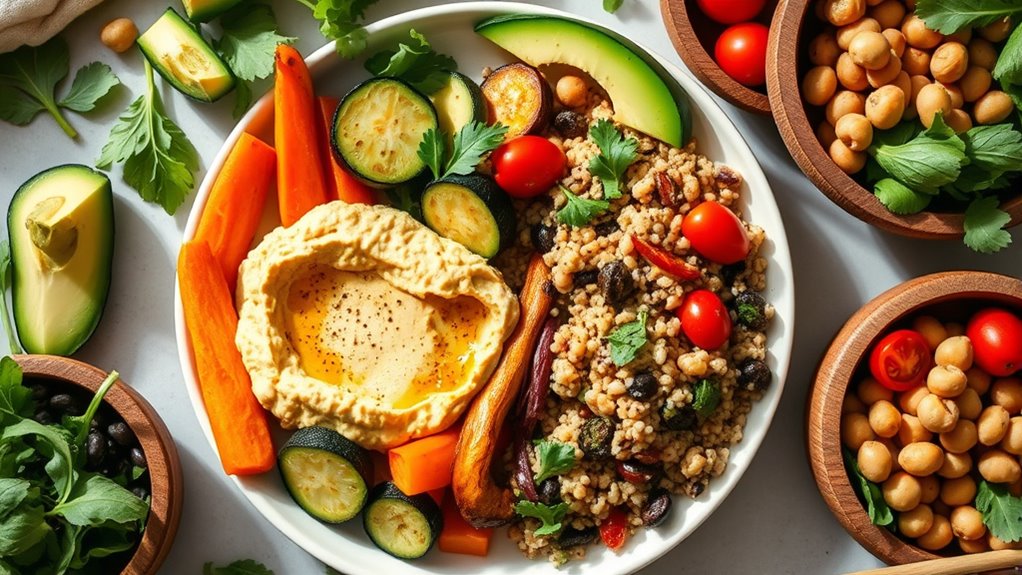Adopting a plant-forward meal plan as a flexitarian means focusing on filling half your plate with vegetables and fruits, a quarter with whole grains, and the rest with plant proteins like beans and tofu. Start small by adding plant-based meals a few times a week, and plan meals that are diverse, flavorful, and nutritious. Supporting sustainability and your health becomes easier as you incorporate seasonal and minimally processed foods. Continue exploring ways to balance taste and nutrition for a more sustainable lifestyle.
Key Takeaways
- Prioritize filling half your plate with non-starchy vegetables and a quarter each with whole grains and plant-based proteins.
- Incorporate plant proteins like beans, lentils, and tofu into your meals multiple times weekly, gradually increasing plant-based days.
- Plan meals with diverse, seasonal, and minimally processed ingredients to boost nutrient intake and support sustainability.
- Use batch cooking and meal prep strategies to ensure variety and reduce waste; communicate your plant-forward goals with household members.
- Pair iron and zinc-rich plant foods with vitamin C sources to enhance nutrient absorption and maximize nutritional benefits.
Embracing the Flexitarian Approach to Eating
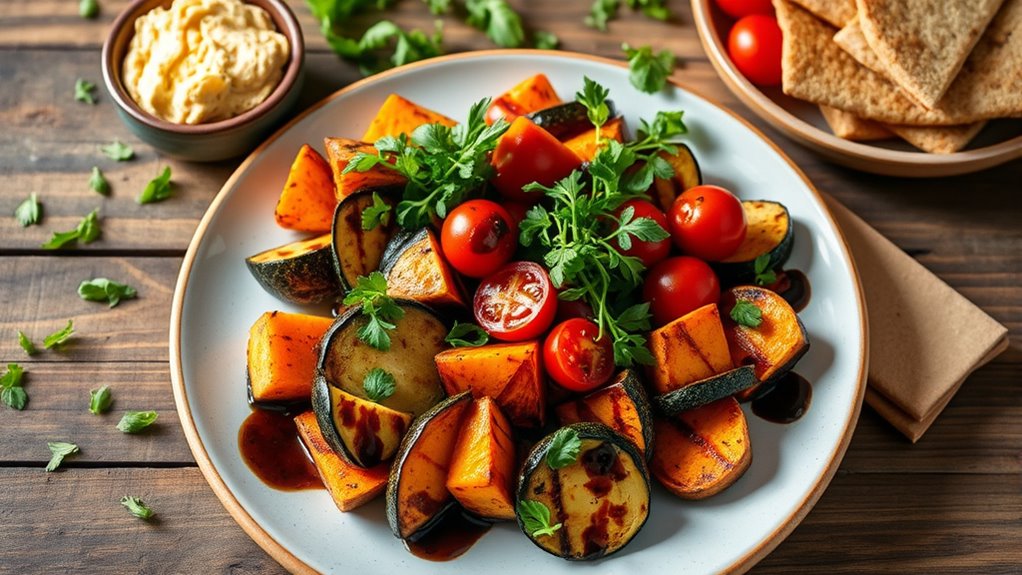
Embracing the flexitarian approach means choosing a balanced diet that includes more plant-based foods while still allowing occasional meat. You focus on whole, minimally processed plant proteins, like beans, nuts, and grains, to boost nutrient density. This flexibility helps you enjoy a variety of foods without strict restrictions, making it easier to stick with healthy habits. By moderating animal products such as meat, dairy, and fish, you can reduce your environmental impact and support sustainability. This approach also offers health benefits, like lowering heart disease risk, supporting weight management, and reducing diabetes and cancer risks. It’s about creating a sustainable, inclusive way to eat that’s adaptable to your lifestyle while promoting overall well-being and environmental responsibility.
Building a Balanced Plate With Plant-Based Focus
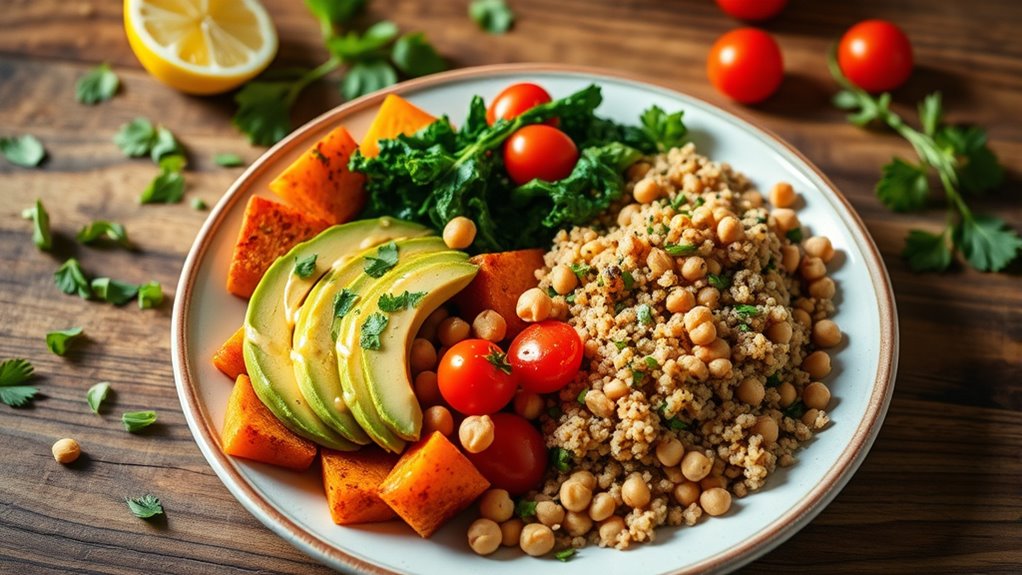
Creating a balanced plate with a plant-based focus involves thoughtfully distributing different food groups to maximize nutrition and enjoyment. Aim for half of your plate to be filled with non-starchy vegetables like spinach, kale, broccoli, or zucchini, providing vitamins and fiber. Fill about a quarter with whole grains such as rice, quinoa, or oats, offering essential nutrients and energy. Allocate another quarter to plant-based proteins like beans, lentils, or tofu to meet your protein needs. Incorporate healthy fats from sources like nuts, seeds, or avocados, and include a variety of fruits for added vitamins and minerals. Balancing these elements secures your meal is nutritious, satisfying, and aligned with a plant-forward approach, supporting both your health and environmental goals. Educational toys can also be integrated into meal planning by engaging children in cooking activities that promote healthy eating habits. Additionally, understanding market trends can help you select the most nutritious and sustainable ingredients for your meals.
Starting Small: Incorporating More Plant Meals Gradually
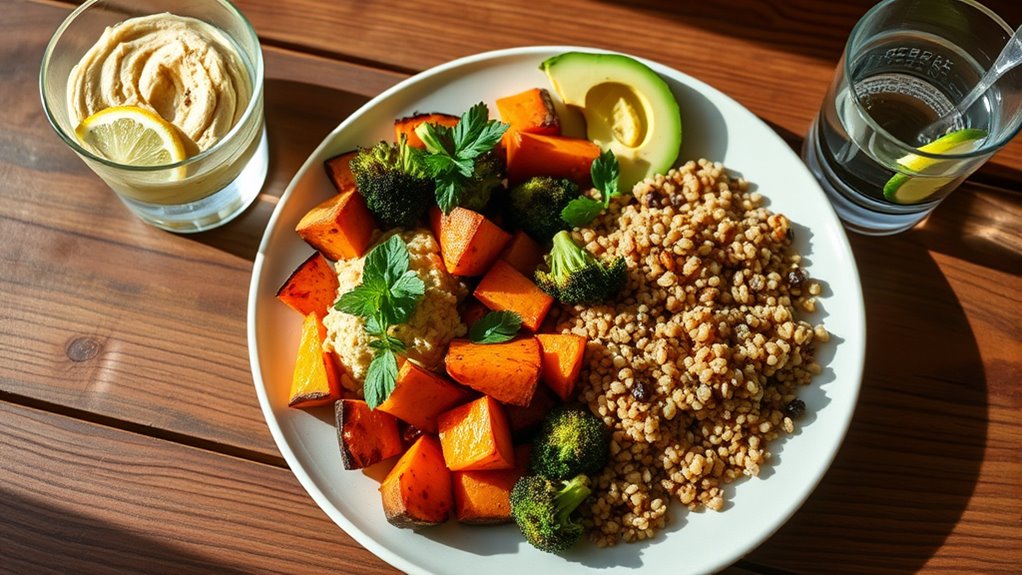
Starting small makes it easier to shift into a flexitarian diet without feeling overwhelmed. Begin by dedicating one or two days a week to plant-based meals, gradually reducing your meat intake. Start with one plant-based meal per day and increase it over time. Incorporate plant proteins like beans, lentils, tofu, and meat alternatives to maintain your protein needs. Experiment with different recipes—vegetable stews, legume salads, stir-fries—to add variety and keep meals exciting. Be prepared for social and cultural challenges; communicate your goals with friends and family for support. This gradual approach not only makes the transition manageable but also helps you enjoy the health, environmental, and nutritional benefits without feeling deprived. Mindful decluttering can also help you create a kitchen space that encourages healthy, plant-forward cooking habits. Additionally, understanding potential pitfalls in adopting new payment technologies can help you navigate the financial and security aspects of making lifestyle changes. Being aware of AI in Education developments can also inspire innovative ways to learn about nutrition and sustainable living. Incorporating plant-based ingredients into your pantry can further support your transition and make plant meals more accessible and enjoyable. Recognizing the importance of self-protection strategies during dietary changes can help you stay focused and resilient amidst social pressures.
Meal Planning Tips for a Sustainable and Nutritious Diet
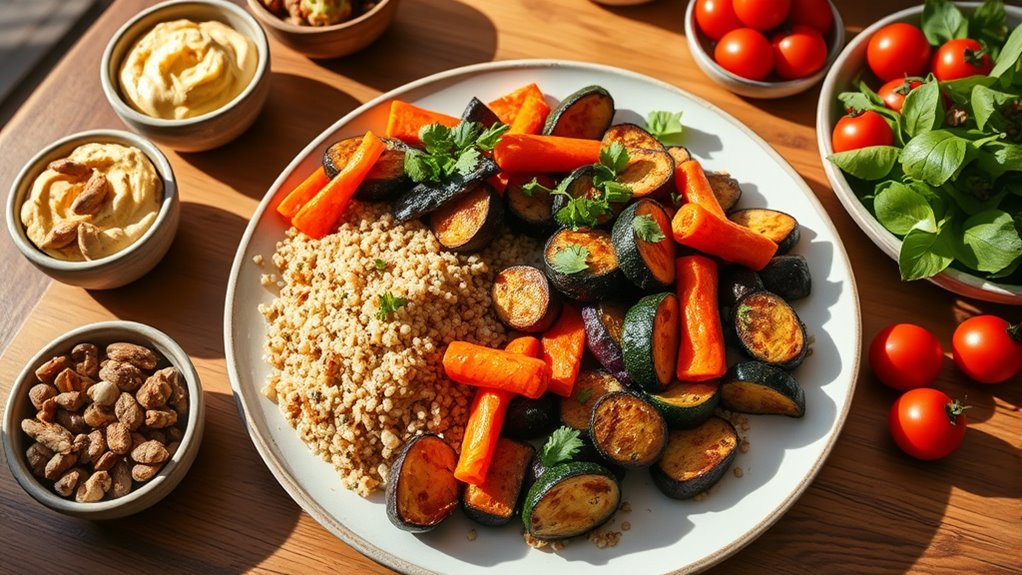
Effective meal planning plays a key role in maintaining a flexitarian diet that is both sustainable and nutritious. Focus on whole plant foods like fruits, vegetables, legumes, nuts, seeds, and whole grains to maximize nutrients and reduce environmental impact. Incorporate diverse protein sources such as beans, lentils, tofu, eggs, dairy, and occasional lean meat or seafood to meet your protein needs. Pair iron and zinc-rich foods like spinach, legumes, and nuts with vitamin C-rich options to boost absorption. Include omega-3 sources like flaxseeds, walnuts, and chia seeds, along with occasional fatty fish. Planning meals around plant-based mains, rotating proteins, and using batch cooking helps minimize waste and ensures nutrient variety. Gradually reducing meat and emphasizing seasonal, local, and minimally processed foods support long-term sustainability.
Delicious Recipes to Expand Your Flexitarian Repertoire
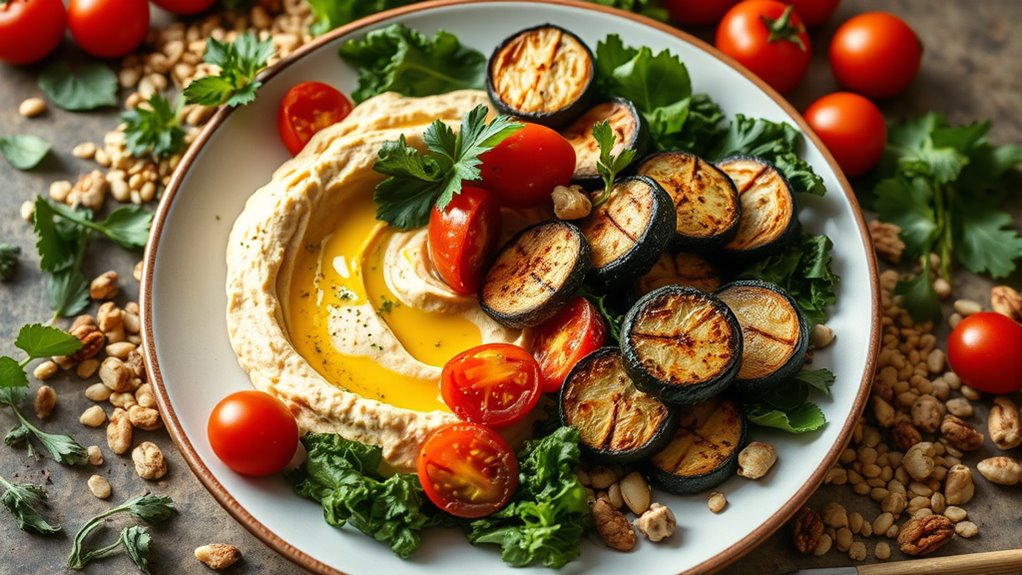
To broaden your flexitarian repertoire, exploring a variety of delicious recipes can make plant-based eating both enjoyable and practical. Start with hearty main dishes like sweet potato and black bean chili, packed with protein and fiber. Try spaghetti with spinach and sun-dried tomatoes for a vibrant twist on pasta, or zucchini ravioli filled with ricotta and topped with marinara. Mediterranean Buddha bowls offer customizable, nutrient-rich options, while winter vegetable stews provide warmth and comfort. Soups like lentil or butternut squash are easy to prepare and satisfying. Incorporate vegan options such as quinoa salads or grilled tofu to diversify flavors. Meals with optional meat, like stuffed peppers or quinoa bowls, give you flexibility. Finally, global-inspired dishes like Indian curries or Korean bibimbap add exciting variety to your menu. Be mindful of the odor of ingredients, as some plant-based foods or condiments can have strong smells that enhance the dining experience. Additionally, understanding survivalism techniques such as food preservation can help you stockpile ingredients for busy days or emergencies. Moreover, practicing shifting gears techniques can help manage the pace of your meal prep, especially when handling multiple dishes simultaneously. Incorporating tuning principles to your meal planning can also help optimize ingredient use and ensure balanced nutrition.
Benefits of Plant-Forward Eating for Health and the Environment
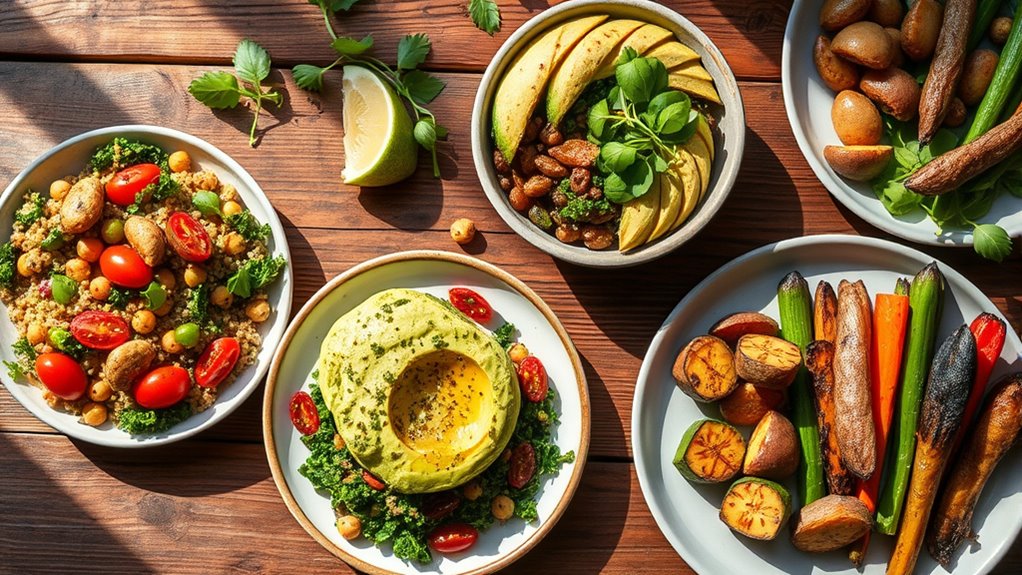
Embracing a plant-forward diet offers significant health benefits while positively impacting the environment. By eating more plant-based foods, you lower your risk of heart disease through reduced saturated fats and increased fiber. It can also help prevent and manage type 2 diabetes by improving insulin sensitivity and support weight management with fiber-rich, lower-calorie options. Your digestive health benefits from high-fiber foods that reduce constipation. Nutritionally, you gain essential vitamins, minerals, and antioxidants that boost overall health. Environmentally, plant-focused eating cuts greenhouse gas emissions, conserves water, and preserves biodiversity. It also reduces energy use in livestock farming and minimizes land deforestation. Incorporating electric bikes into your daily routine can further promote sustainable transportation options. Additionally, choosing seasonal and locally sourced produce can reduce your carbon footprint and support local farmers. Practicing mindful food choices and reducing waste further enhances the positive impact of your diet. Overall, a plant-forward approach promotes sustainable food systems while supporting your health and the planet’s well-being.
Frequently Asked Questions
How Can I Ensure I Get Enough Protein on a Flexitarian Diet?
You want to make sure you get enough protein on a flexitarian diet. Focus on including a variety of sources like legumes, soy products, nuts, seeds, whole grains, dairy, and eggs. Pair plant proteins with grains or seeds to complete amino acids. Keep track of your intake, aiming for at least 0.8g per kg of body weight daily, and consider supplementing with high-quality options if needed.
What Are Easy Plant-Based Substitutions for Meat in Recipes?
Imagine your plate as a canvas, and plant-based substitutes as vibrant brushstrokes. You can easily swap ground meat with cooked lentils blended with mushrooms and walnuts, or crumble tofu seasoned with spices. Sliced seitan or marinated mushrooms work wonderfully in stir-fries and pizzas. Jackfruit adds a shredded, pulled texture perfect for tacos or sandwiches. These simple swaps keep your dishes flavorful, satisfying, and colorful, all while embracing plant-based goodness.
How Do I Maintain Variety in My Plant-Forward Meal Plan?
To keep your meals exciting, focus on rotating ingredients like vegetables, fruits, and grains regularly. Experiment with herbs and spices to add new flavors, and try cooking different recipes often. Incorporate various protein sources such as beans, tofu, and lentils, and use seasonal produce for freshness. Drawing inspiration from diverse cuisines maintains variety and guarantees your meals stay nutritious and flavorful.
Are There Specific Nutrients I Should Watch Out for in a Flexitarian Diet?
Like a modern-day Renaissance man, you need to be aware of key nutrients in your flexitarian diet. Watch out for vitamin B12, mainly in animal products, and make certain you’re getting enough omega-3s if you don’t eat fish often. Keep an eye on your calcium and iron intake, using plant sources and vitamin C to maximize absorption. Supplement wisely, and balance your meals to stay nourished and healthy.
How Can I Adapt Flexitarian Meal Planning for a Busy Lifestyle?
To adapt flexitarian meal planning for a busy lifestyle, you should prioritize quick, nutritious meals that fit your schedule. Use a meal planning template to organize your week, incorporate easy plant-based staples, and prep ingredients in advance. Keep your pantry stocked with versatile basics, batch cook, and portion meals for grab-and-go convenience. Flexibility is key, so include small amounts of animal proteins and a variety of vegetables to stay balanced and energized.
Conclusion
By gradually embracing plant-forward meals, you can improve your health and reduce your environmental impact. For example, Sarah started replacing meat with beans and vegetables twice a week, noticing increased energy and lower grocery bills. Small changes like these make a big difference over time, helping you build a sustainable, nutritious diet. Keep experimenting with new recipes and enjoy the positive impact on your well-being and the planet’s health.
